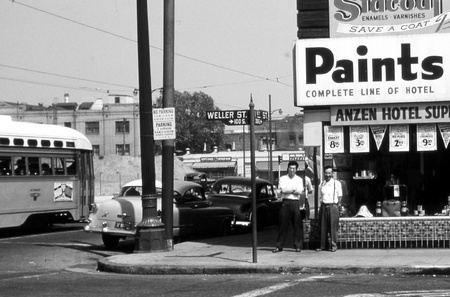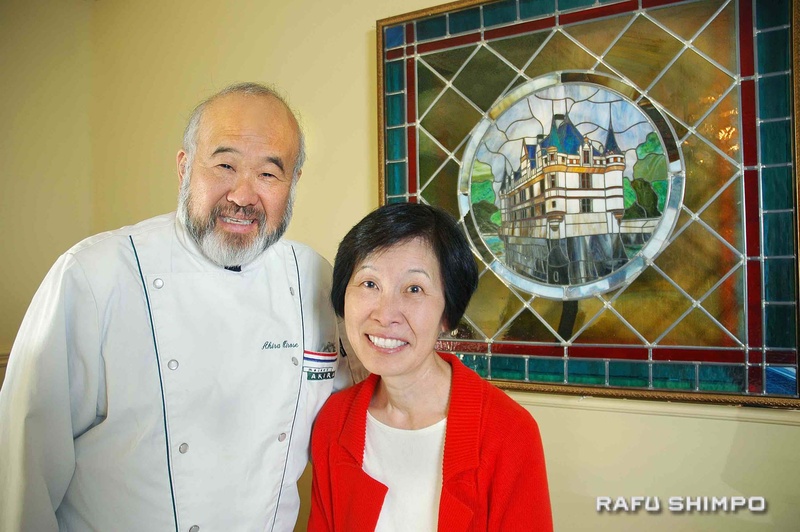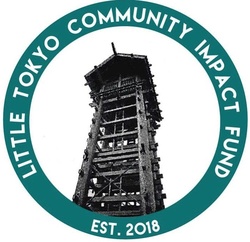Community control over land in Little Tokyo is one of the few strategies that will help prevent displacement of legacy small businesses. The Little Tokyo Community Impact Fund (LTCIF) will protect our neighborhood from losing its cultural heritage and will help achieve community control.
— Takao Suzuki, LTCIF member
In 1886 Charles Kame, an ex-seaman from Japan opened a Japanese restaurant at 340 E. First St., planting the roots of Little Tokyo. The community grew slowly but steadily as more Issei immigrated to California, including a large influx in the early 1900s, as thousands left San Francisco to escape heightened racial tensions after the 1906 earthquake.
It was never easy. Federal laws denied citizenship. State legislation barred property ownership. Local law practiced employment and housing discrimination. And still the fighting spirit of the Issei was strong. Eventually the predominantly male immigrants decided to settle in Los Angeles and raise families, and Little Tokyo changed from a bachelor enclave into a community.
The Issei created an economic niche in agriculture, fishing, wholesale produce, retailing; they built a community infrastructure of churches, temples, hospitals, businesses and community institutions. Some of these legacy businesses, buildings and institutions still stand in Little Tokyo today, and we honor these proud testimonials to our history and legacy.
Despite pervasive racism and discrimination, Little Tokyo became a bustling community, a place people could call home. By 1941 there were 30,000 Japanese in Little Tokyo.
Until WWII, which brought about the unjust imprisonment of 120,000 Americans of Japanese ancestry into concentration camps surrounded by barbed wire and armed guards. Churches, temples, homes and shops were shuttered and left Little Tokyo an abandoned ghost town. Properties were “acquired” by the city. Some describe this as the first wave in Little Tokyo redevelopment history.
During those years, African Americans from the South came to L.A. seeking wartime jobs, but could not find places to live due to restrictive housing covenants. Little Tokyo did not have such covenants. African Americans moved in, established businesses and nightclubs, and the area became known as “Bronzeville.” When the war ended, the wartime jobs dried up, Japanese Americans were released, and many returned to Little Tokyo.
Tsutomu Maehara was one of those who came to Little Tokyo. Born in Portland, Ore. and educated in Japan, he had returned to Oregon in 1937 and joined an import firm when the war broke out. He was sent to Tule Lake, but was released shortly after to farm with his sister’s family in Oregon until the end of the war.
In 1945, Japanese American families returning from concentration camps needed jobs and housing. Many became managers and owners of small hotels in Little Tokyo as well as the predominantly African American section of downtown L.A.’s Skid Row, where they could live while also earning income from room rentals. Eventually, there were an estimated 400 such hotels.
Maehara hit upon the idea of providing them with linen service and cleaning supplies. In 1946, at age 26, he established Anzen Hotel Supply and subsequently opened Anzen Hardware on East First Street in Little Tokyo.
His contemporaries included pioneering JAs like photographer Toyo Miyatake, land developer and former L.A. Harbor Commissioner Taul Watanabe, clothier Joseph Ito, civil rights attorney Tetsujiro “Tex” Nakamura, Fish King’s Masashi Kawaguchi, and others established businesses to serve the needs of those returning to L.A. after the war.
— Ellen Endo, Rafu Shimpo, June 14, 2018

Tsutomu and Kinuko Maehara had two sons, Nolan and Norman, and two daughters, Jo Ann and Rosanne. Jo Ann was born in L.A. at the Japanese Hospital. She grew up in the Silverlake area and attended John Marshall High before going to USC. Jo Ann’s early memories are rich with Little Tokyo lore.
“All shopping took place in Little Tokyo,” she remembers. “Mom was committed to support the businesses there.” Loyalty to the community was important to the Maeharas. “When we needed shoes for school, we would go to Asahi Shoes. Whatever they had in stock, those were the shoes we would get.”
When she wasn’t running around in her dad’s store, Anzen, Jo Ann would go shopping with her mom. “We would go to Enbun Market, Ida Market and Modern Food for groceries. It would be Joseph’s Men’s Wear for my dad’s clothes. Then Mikawaya, Fukuya, and Fugetsudo for snow cones, manju, and candy. Rafu Bussan for all our gifts. And Dr. Paul Yamauchi and Dr. George Kambara for doctor visits.”
Other early memories include family meals at Ichiban, Horikawa, Nancy’s Stand, Yatsuhashi, Kawafuku, San Kwo Low, Far East Café, Matsuno Sushi, Tokyo Café, Tokyo Kaikan, Aoi Restaurant, Poppy’s, Mitsuru Café, Koharu, etc. Her recollections are like a trip down memory lane.
Jo Ann’s relationship with Little Tokyo is evocative of the role Little Tokyo has played in so many of our lives as the cultural heart of the JA community.
Today, with few exceptions, almost all of these legacy businesses, these precious cornerstones of our JA childhood and cultural heritage, are gone.
As a resident of Little Tokyo for the past 8 years, I see it has become urgent that we focus on preserving Little Tokyo’s ethnic enclave. We owe it to the Issei and Nisei who built our community to maintain it because it would be a shame to see it disappear. We need to keep the kimochi (heart) for Little Tokyo alive for future generations.
— Patty Nagano, LTCIF member
In 1953, the construction of the Parker Center police complex resulted in the massive demolition of property. Nearly 1,000 people and one-fourth of the district’s commercial frontage was destroyed.
Before Parker Center, the site contained two of the most vibrant blocks in Little Tokyo. It housed many small mom-and-pop businesses and cultural organizations serving the Japanese American community.
Starting in 1948, the city earmarked these blocks as part of a Civic Center expansion plan and an early form of urban renewal. The site was cleared of all existing buildings — many of which would be considered historic if still standing. The property was remade into a single superblock, with Parker Center’s construction beginning in 1952 …
Thousands of historic buildings, as well as part or all of neighborhoods such as Little Tokyo and Bunker Hill, were lost during this era of massive urban redevelopment. Parker Center’s construction was particularly hard felt: in addition to displacing hundreds of Japanese Americans, it spurred feelings that history was repeating itself, as some of these same had been forcibly removed just a decade earlier and confined in World War II internment camps.
— L.A. Conservancy, “Preserving Places with Difficult Histories: Parker Center,” Jan. 31, 2017
During the 1970s, the plans to widen First Street and extend Civic Center deeper into Little Tokyo sparked concern resulting in a Redevelopment Plan adopted by the city that promised housing, a community center, office buildings and a recreational center.
Community coalitions made up of residents, businesses and community such as LTPRO (Little Tokyo People’s Rights Organization) challenged ongoing evictions caused by redevelopment, fought for affordable housing for our seniors, and struggled to make sure that commitments made by the city and CRA (Community Redevelopment Agency) were honored.
Japanese construction monolith Kajima Corporation was set to oversee the Little Tokyo Project, but was not sensitive to the JA immigrant experience that had historically shaped Little Tokyo, creating further problems.
At every juncture of forced relocation — war, redevelopment, gentrification — the community has taken a hit. Before the war, there were 43 Little Tokyos in the United States. Today, there are only four. Each time, L.A.’s Little Tokyo has rallied and survived. Kept alive by strong community support, and steadfast families, like that of Tsutomu Maehara, who were invested in and committed to building and rebuilding; to preserving Little Tokyo as a cultural home for the JA community.
In real estate there are a few axioms — such as ‘If you don’t own it, you can’t control it’ and ‘Timing is everything.’ Now is the time for good people to join together to own and control parcels in Little Tokyo so we can preserve this historic neighborhood that represents our history, heritage, and culture — and the timing is right now!
— Bill Watanabe, LTCIF member
“My dad still owns the (original Anzen) building on 220 E. First and Weller streets,” says Jo Ann. In 1971 in the midst of the Little Tokyo redevelopment and after the Sylmar earthquake, Anzen moved to its second location next to Far East Café. After the Northridge earthquake in 1994, Anzen moved to its current location on 309 E. First St., which is part of the LT Historic District.
Little Tokyo has always been a part of Jo Ann’s life. After college, she came back to Little Tokyo to work as a dental hygienist at the 321 Medical Building. But her life took an unexpected turn.
“I was interested in cooking. I always liked to cook. One day I saw an ad for a job at L’Orangerie, ‘no experience needed’!” She applied and got the job. It turns out the ad was placed by Akira Hirose, her future husband.
Chef Hirose was born in Kyoto. He was very future-oriented and at 18 years old, he moved to France. There he caught the attention of and was invited to train under noted chef and restaurateur Joel Robuchan (named Chef of the Year by Gault Millau in 1989, he won more Michelin Guide stars than any chef in the world). Chef Akira went on to work at Maxim’s in Paris, and studied the fine art of pastry-making at Ecole de Lenotre.
In 1981 he came to L.A. and worked at L’Orangerie. And he met Jo Ann Maehara.
Shortly after, he returned to Japan. “We courted for a year,” Jo Ann says. “The phone bills were astronomical – my mom said it would be cheaper just to fly to Japan.” In two years, in 1983, he had opened Azay Le Rideau, which was voted one of the top 50 French restaurants in Japan.
“We got married in Kyoto at Nishihongwanji head temple,” Jo Ann says. “But I returned to give birth to both of my children here in Los Angeles, then flew back to Japan. We returned as a family seven years later in 1991; by then Michelle was 5¾ years old, and Phillip was 1¾ years old.”
Back in L.A., Chef Akira worked to re-establish himself as a lead chef. He became the pastry chef at Citrus. Then he went on to chef at the Georgian Room at the Ritz Carlton. He became seafood chef at Belvedere Restaurant at the Peninsula Hotel in 1991-93 when the Northridge earthquake hit, and he was “forced” to take a room there until it was deemed safe to travel home. In 1998, Maison Akira opened to much fanfare in Pasadena. There he was voted Chef of the Year by the Southern California French Chef Association, and Maison Akira was rated one of the Top 40 Restaurants by Zagat.
Throughout, Jo Ann and Chef Akira have kept Little Tokyo close. Maison Akira has become a familiar name at large events, giving JA community fundraising dinners a touch of class: including Go For Broke, JANM, JACCC, LTSC and so on. Jo Ann continues to work in a Little Tokyo dental oiffice, and does volunteer work.
Last year, the Little Tokyo Community Impact Fund held its inaugural meeting to talk about current losses of key heritage businesses. Jo Ann was there and spoke out in support of investing in the community.
Little Tokyo is the cultural heart of the JA community. To protect the historical legacy and cultural identity of Little Tokyo today requires community control of our real estate. For many people, community control through real estate investment is a new paradigm. The LTCIF is a new and creative collaboration, and an important investment opportunity.
— Miya Iwataki, LTCIF member
In 2019, Chef Akira decided to close Maison Akira — much to the chagrin of its fans. But, like the Circle of Life, the Maehara-Hiroses are opening a new French restaurant in Little Tokyo!! In the building where the original Anzen once stood.
“My Dad always wanted to keep this property to be used by the community,” says Jo Ann. And now they’ve come full circle.
In 1954, Nori Takatani walked into Anzen Hardware store, and never left. Loyalty. These days he can be found keeping shop at Anzen, still located on 309 E. First St. in the Little Tokyo Historic District. He is now the owner of this legacy business filled with delicate bonsai scissors, sushi-grade knives, water sharpening stones, gadgets only available in Japan.
In 1995, the north side of First Street was declared the Little Tokyo Historic District by the Department of Interior. But today, the challenges continue. Construction of the Regional Connector Metro Station at First and Central will create the busiest traffic hub in L.A. outside of Union Station running through the heart of Little Tokyo. This has again sparked outside interest, and skyrocketing rents in Downtown L.A.

And once again, we are seeing mom-and-pop stores forced to close or relocate in the face of untenable rent increases, and building owners eager to capitalize on increasing land values.
The Little Tokyo Community Impact Fund has been formed to offer an opportunity for strategic and collaborative investment in LT heritage properties by those who want to invest in the future of Little Tokyo. And thus, provide an avenue for legacy businesses to maintain their cultural and historical integrity despite outside challenges and pressures.
As transit comes to Little Tokyo, the LTCIF is an idea whose time has come. We need to act quickly as a community to capitalize this fund so that we maintain our strong stake and influence in the future of Little Tokyo. We have the experience and leadership to launch this effort and I’m excited about the possibilities LTCIF will bring. It’s a unique effort nationally, so we have an opportunity to be a national model for community driven investment strategies.
— Lisa Hasegawa, LTCIF member
The LTCIF is an unprecedented opportunity to come together and work toward a future that reflects our community while honoring its past. To me, that’s something worth investing in.
— Kevin Sanada, LTCIF member
Can you imagine Little Tokyo not being here? What a devastating loss it would be! Imagine coming back in the future and seeing signs of ‘Historic Little Tokyo’ or ‘Historical Japantown’ a place the exists only in history books or in the fading memory of the elders. Imagining that breaks my heart. Just to think of our parents and grandparents and what they endured and built for us, and are we to let it slowly slip away? We can’t let that happen.
— Steve Nagano
LTCIF: HOW YOU CAN GET INVOLVED
Gentrification — a process that looks to the future but threatens the past. Unless the real estate that houses legacy businesses can be secured, the future of Little Tokyo will always be uncertain. Little Tokyo Community Impact Fund seeks to protect the past, impact the present and solidify the future of Little Tokyo by purchasing real estate that will provide a home for many of these businesses.
We will be hosting a series of community meetings in Los Angeles County. The first one will take place on Aug. 24 at Union Church in Little Tokyo, 11 a.m. in Japanese, 1 p.m. in English.
If you’d like to get involved you can also:
• Visit LittleTokyoCIF.com to learn about the fund and upcoming meetings
• Come to an informational meeting
• Review the investment agreement (available at the meetings or on LittleTokyoCIF.com)
• Decide if investing is right for you
LITTLE TOKYO COMMUNITY IMPACT FUND MISSION
Protect the Past
Little Tokyo, one of four remaining Japan Towns in the United States, has a rich cultural history and is a significant part of the Japanese American experience in Los Angeles. Preserving the legacy of Japanese American family-owned businesses, cultural institutions, and spiritual centers is critical as pressure from outside investors increases. Controlling real estate within the community will keep gentrification from changing the cultural identity and landscape of the area.
Impact the Present
The Little Tokyo Community Impact Fund will create a public/private partnership and platform to allow individuals, foundations, and the local government to invest collaboratively in the Japanese American community. The Fund will be led by long-standing stakeholders, experts in real estate and finance, and members of the non-profit sector in Little Tokyo. Legacy owners will be provided the opportunity to sell their property to the Fund in order to maintain the historical value and priorities of the community.
Solidify the Future
The Little Tokyo Community Impact Fund will provide Japanese American owners of real estate an avenue to maintain their legacy and impact on the community despite challenges and pressures from outside. Family-owned businesses will be able to continue to operate within the community with the help of the Fund’s pool of investors. By investing collaboratively with the Community Impact Fund, the cultural integrity of Little Tokyo will be preserved for future generations.
*This article was originally published by the Rafu Shimpo on July 24, 2019.
© 2019 Miya Iwataki







